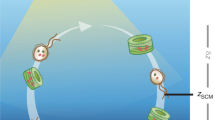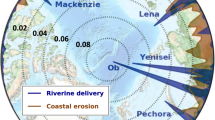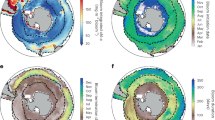Abstract
Primary productivity in the oceans is limited by the lack of nutrients in surface waters. These nutrients are mostly supplied from nutrient-rich subsurface waters through upwelling and vertical mixing1, but in the ocean gyres these mechanisms do not fully account for the observed productivity2. Recently, the upward pumping of nutrients, through the action of eddies, has been shown to account for the remainder of the primary productivity; however, these were regional studies which focused on mesoscale (100-km-scale) eddies3,4,5,6. Here we analyse remotely sensed chlorophyll and sea-surface-height data collected over two years and show that 1,000-km-scale planetary waves, which propagate in a westward direction in the oceans, are associated with about 5 to 20% of the observed variability in chlorophyll concentration (after low-frequency and large-scale variations are removed from the data). Enhanced primary production is the likely explanation for this observation, and if that is the case, propagating disturbances introduce nutrients to surface waters on a global scale—similar to the nutrient pumping that occurs within distinct eddies.
This is a preview of subscription content, access via your institution
Access options
Subscribe to this journal
Receive 51 print issues and online access
$199.00 per year
only $3.90 per issue
Buy this article
- Purchase on Springer Link
- Instant access to full article PDF
Prices may be subject to local taxes which are calculated during checkout




Similar content being viewed by others
References
Barber, R. T. in Primary Productivity and Biogeochemical Cycles in the Sea (eds Falkowski, P. G. & Woodhead, A. D.) 89–106 (Plenum, New York, 1992).
Jenkins, W. J. & Goldman, J. C. Seasonal oxygen cycling and primary production in the Sargasso Sea. J. Mar. Res. 43, 465–491 (1985).
McGillicuddy, D. J. Jr & Robinson, A. R. Eddy-induced nutrient supply and new production in the Sargasso Sea. Deep-Sea Res. 44, 1427–1450 (1997).
Siegel, D. A., McGillicuddy, D. J. Jr & Fields, E. A. Mesoscale eddies, satellite altimetry and new production in the Sargasso Sea. J. Geophys. Res. 104, 13359–13379 (1999).
McGillicuddy, D. J. Jr et al. Mesoscale variations of biogeochemical properties in the Sargasso Sea. J. Geophys. Res. 104, 13381–13394 (1999).
McGillicuddy, D. J. Jr, Kosnyrev, V. K., Ryan, J. P. & Yoder, J. A. Covariation of mesoscale ocean color and sea surface temperature patterns in the Sargasso Sea. Deep-Sea Res. (in the press).
Chelton, D. M & Schlax, M. Global observation of oceanic Rossby waves. Science 272, 234–238 (1996).
Stammer, D. Global characteristics of ocean variability estimated from regional TOPEX/POSEIDON altimeter measurements. J. Phys. Oceanogr. 27, 1743–1769 (1997).
Polito, P. & Cornillon, P. Long baroclinic Rossby waves detected by TOPEX/POSEIDON. J. Geophys. Res. 102, 3215–3235 (1997).
Halliwell, G. R. & Cornillon, P. Westward-propagating SST anomaly features in the Sargasso Sea, 1982-88. J. Phys. Oceanogr. 21, 635–649 (1991).
Van Woert, M. L. & Price, J. M. Geosat and advanced very high resolution radiometer observations of oceanic planetary waves adjacent to the Hawaiian islands. J. Geophys. Res. 98, 14619–14631 (1993).
Cipollini, P. et al. Concurrent altimeter and infrared observations of Rossby wave propagation near 34° N in the Northeast Atlantic. Geophys. Res. Lett. 24, 889–892 (1997).
McClain, C. R. et al. Science quality SeaWiFS data for global biosphere research. Sea Technol. 39, 10–16 (1998).
Zang, X. & Wunsch, C. The observed dispersion relationship for North Pacific Rossby wave motions. J. Phys. Oceangr. 29, 2183–2190 (1999).
Chelton, D. B. et al. Geographical variability of the first baroclinic Rossby radius of deformation. J. Phys. Oceangr. 28, 433–460 (1998).
McGillicuddy, D. J. et al. Influence of mesoscale eddies on new production in the Sargasso Sea. Nature 394, 263–266 (1998).
Hayward, T. L. The nutrient distribution and primary production in the central North Pacific. Deep-Sea Res. 34, 1593–1627 (1987).
IEEE Programs for Digital Signal Processing, Algorithm 5.1 (IEEE Press, New York, 1979).
Emery, W. J. & Thomson, R. E. Data Analysis Methods in Physical Oceanography (Pergamon, Oxford/New York, 1997).
Lim, J. S. Two-Dimensional Signal and Image Processing 42–45 (Prentice Hall, Englewood Cliffs, New Jersey, 1990).
Acknowledgements
We thank the SeaWiFS team for chlorophyll data and AVISO for SSH data; we also thank D. Siegel, P. Polito and S. Schollaert for discussions and recommendations. This work was supported by NASA.
Author information
Authors and Affiliations
Corresponding author
Rights and permissions
About this article
Cite this article
Uz, B., Yoder, J. & Osychny, V. Pumping of nutrients to ocean surface waters by the action of propagating planetary waves. Nature 409, 597–600 (2001). https://doi.org/10.1038/35054527
Received:
Accepted:
Issue Date:
DOI: https://doi.org/10.1038/35054527
This article is cited by
-
The Emergence of Life
Space Science Reviews (2019)
-
Dynamics of westward propagation and intensification of Lakshadweep low in the southern Arabian Sea
Ocean Dynamics (2019)
-
Water mass characteristics in the western North Pacific based on a streamfunction projection
Science China Earth Sciences (2015)
-
Modulation of tropical ocean surface chlorophyll by the Madden–Julian Oscillation
Climate Dynamics (2013)
-
Enhancement of biological productivity by internal waves: observations in the summertime in the northern South China Sea
Journal of Oceanography (2012)
Comments
By submitting a comment you agree to abide by our Terms and Community Guidelines. If you find something abusive or that does not comply with our terms or guidelines please flag it as inappropriate.



